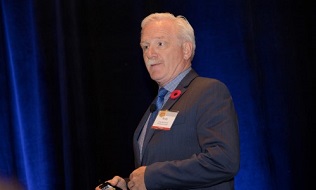

Given the stressful nature of their jobs, Canada’s first responders ― police, paramedics, firefighters and correctional workers ― are living with much higher rates of mental disorders than the general population, according to a recent national survey published in the Canadian Journal of Psychiatry.
“It’s a community that’s hurting,” Andy MacDonald, a veteran firefighter and first responder community consultant for Homewood Health Inc., told attendees at Benefits Canada’s 2017 Mental Health Summit in Toronto on Nov. 7.
MacDonald acknowledged the macho culture of silence as something that’s exacerbating the problem by discouraging and stigmatizing any signs of emotional weakness.
Read: Workplace wellness incomplete without financial fitness
“The first responder culture doesn’t allow you to be different, to show emotion, to cry,” he said. “Suck it up. Harden up. Man up,” he added, referring to common refrains in the community.
But a lifetime of watching people die and co-workers suffer can take its toll, according to MacDonald, who noted the high rates of operational stress injury and post-traumatic stress disorder among first responders. And the impact, he added, is measurable. “Presenteeism is a big problem among first responders.”
Suicide rates among first responders are also very high. MacDonald cited a survey from an article published in the Journal of Emergency Medical Services that found that of the more than 4,000 first responders surveyed, 6.6 per cent had attempted suicide some time in their career. That’s 10 times the rate in the general population.
MacDonald blamed disapproval, discrimination and discontent with anyone who differs from social and cultural norms for the worrying statistics. He underscored the urgent need to de-stigmatize mental suffering and called for a paradigm shift in the culture of first responders. “People need to be able to talk about their painful experiences on a free and open basis.”
Read: Early detection, treatment key to addressing mental disorders
During his tenure as fire chief in Brampton, Ont., MacDonald attempted to become a part of that shift. “We built five new fire stations and designed them all around the kitchen. That’s where most of our conversations take place at the fire station. It’s a safe environment,” he said.
“We need to extend that metaphorical kitchen table across the first responder world. Allow firefighters to sit around and share anything with their crewmates. Create that secure space. Erase that stigma,” he added.
And when it comes to some of the things that could help first responders cope, MacDonald offered up a list of actions:
- Teach people to build resilience by feeling good about what they do: “If someone died in your arms, there’s nothing you could have done differently to save them,” said MacDonald. “But you can still leave the scene better than you found it. For example, you can turn to the family. Help the children cope. If you’re a paramedic, you can take the time to explain what happened medically. That’s what we teach our people today. That’s what we need to teach them when we recruit them.”
- Do things off duty that make you feel good: Be active in the community, said MacDonald, who also urged for participation in charitable activities.
- Train the leaders: Teach them how to detect the symptoms of operational stress injury and address them before they turn into post-traumatic stress disorder, MacDonald suggested.
- Allow leaders to hurt: They, too, need to be able to feel. “The toughest thing I had to do was tell a 16-year-old his father had committed suicide,” said MacDonald. “I stayed tough through it all. But then I drove around the corner and couldn’t drive for half an hour. I cried because it was OK to cry. The guy was a 25-year friend of mine.”
- Develop a plan and post it: Make employees aware of the plan. “A volunteer firefighter with 25 years of experience committed suicide and left detailed notes about why he did it,” said MacDonald. “He put in great time and thought into taking his life but didn’t put that same time and effort into seeking help because he didn’t know what was available to him.”
- Provide treatment options: It’s also important to communicate them well, according to MacDonald.
- Provide extended support upon return to work: “If we’re going to be open and honest about our feelings, we’re going to have to be open and honest about the treatment we’ve received,” said MacDonald.
- Provide support for the family as well: Offer support and access to an employee and family assistance program.
- Provide peer support: A supportive and empathetic relationship with peers is an important contributor to recovery, according to MacDonald. But it’s also important to enlist professionals with training in trauma care so that first responders who call don’t feel the person on the other end doesn’t understand what they’re going through.
